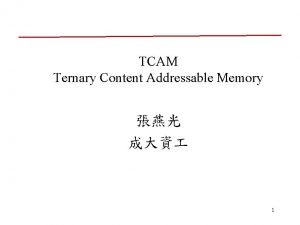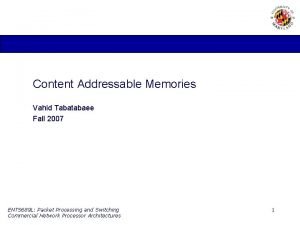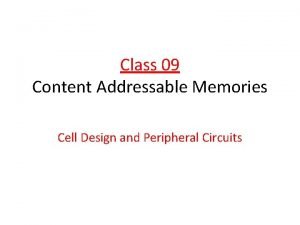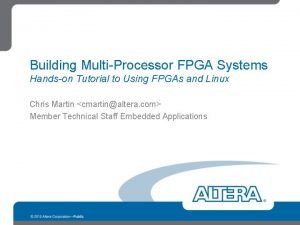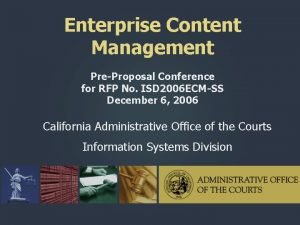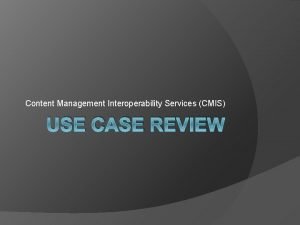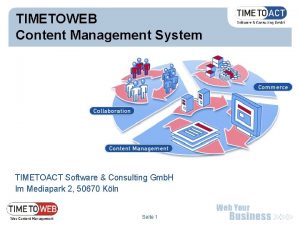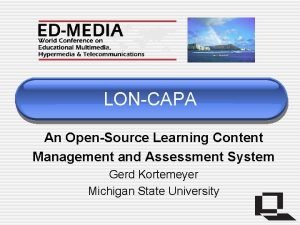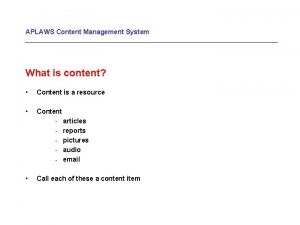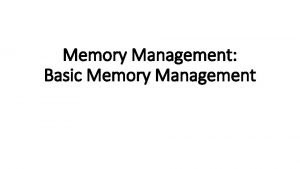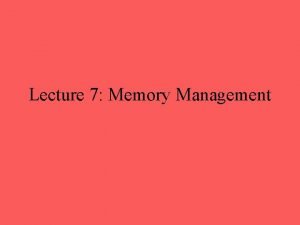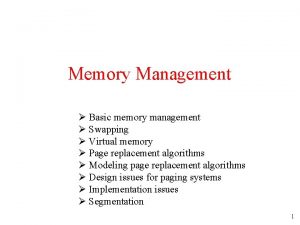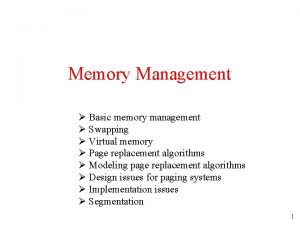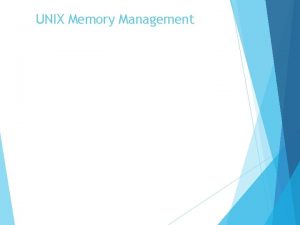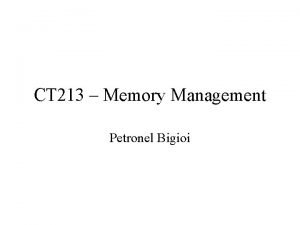Lesson 7 Memory management Content 1 Memory management
































- Slides: 32

Lesson 7 Memory management Content 1. Memory management - history 2. Segmentation 3. Paging and implementation 4. Page table 5. Segmentation with paging AE 4 B 33 OSS Lecture 7 / Page 1 2011

Why memory? • CPU can perform only instruction that is stored in internal memory and all it’s data are stored in internal memory too • Physical address space – physical address is address in internal computer memory – Size of physical address depends on CPU, on size of address bus – Real physical memory is often smaller then the size of the address space • Depends on how much money you can spend for memory. • logical address space – generated by CPU, also referred as virtual address space. It is stored in memory, on hard disk or doesn’t exist if it was not used. – Size of the logical address space depends on CPU but not on address bus AE 4 B 33 OSS Lecture 7 / Page 2 2011

How to use memory • Running program has to be places into memory • Program is transformed to structure that can be implemented by CPU by differen steps – OS decides where the program will be and where the data for the program will be placed – Goal: Bind address of intructions and data to real address in address space • Internal memory stores data and programs that are running or waiting – Long term memory is implemetd by secondary memory (hard drive) • Memory management is part of OS – Application has no access to control memory management • Privilege action – It is not safe to enable aplication to change memory management • It is not effective nor safe AE 4 B 33 OSS Lecture 7 / Page 3 2011

History of memory management • First computer has no memory management – direct access to memory • Advantage of system without memory management – Fast access to memory – Simplementation – Can run without operating system • Disadvantage – Cannot control access to memory – Strong connection to CPU architecture – Limited by CPU architecture • Usage – First computer – 8 bits computers (CPU Intel 8080, Z 80, …) - 8 bits data bus, 16 bits address bus, maximum 64 k. B of memory – Control computers – embedded (only simple control computers) AE 4 B 33 OSS Lecture 7 / Page 4 2011

First memory management - Overlays • First solution, how to use more memory than the physical address space allows – Special instruction to switch part of the memory to access by address bus • Overlays are defined by user and implemented by compiler Common part – Minimal support from OS – It is not simple to divid data or program to overlays Overlay 1 AE 4 B 33 OSS Lecture 7 / Page 5 Overlay 2 2011

Virtual memory • Demand for bigger protected memory that is managed by somebody else (OS) • Solution is virtual memory that is somehow mapped into real physical memory • 1959 -1962 first computer Atlas Computer from Manchesteru with virtual memory (size of the memory was 576 k. B) implemented by paging • 1961 - Burroughs creates computer B 5000 that uses segment for virtual memory • Intel – 1978 processor 8086 – first PC – simple segments – 1982 processor 80286 – protected mode – real segmentation – 1985 processor 80386 – full virtual memory with segmentation and paging AE 4 B 33 OSS Lecture 7 / Page 6 2011

Simple segemnts – Intel 8086 • Processor 8086 has 16 bits of data bus and 20 bits of address bus. 20 bits is problem. How to get 20 bits numbers? • Solution is “simple” segments • Address is composed with 16 bits address of segment and 16 -bits address of offset inside of the segment. • Physical address is computed as: (segment<<4)+offset • It is not real virtual memory, only system how to use bigger memory • Two types of address – near pointer – contains only address inside of the segment, segment is defined by CPU register – far pointer – pointer between segments, contains segment description and offset AE 4 B 33 OSS Lecture 7 / Page 7 2011

Segmentation – protected mode Intel 80286 • Support for user definition of logical address space – Program is set of segments – Each segment has it’s own meaning: main program, function, data, library, variable, array, . . . • Basic goal – how to transform address (segment, offset) to physical address • Segment table – ST Stack Subrouti ne Working array Sqrt Main program – Function from 2 -D (segment, offset) into 1 -D (address) – One item in segment table: • base – location of segment in physical memory, limit – length of segment – Segment-table base register (STBR) – where is ST in memory – Segment-table length register (STLR) – ST size AE 4 B 33 OSS Lecture 7 / Page 8 2011

Hardware support for segmentation Segment table s limit base CPU s o base + < + limit o Segmentation fault Memory AE 4 B 33 OSS Lecture 7 / Page 9 2011

Segmentation • Advantage of the segmentation – Segment has defined length – It is possible to detect access outside of the segment. It throws new type of error – segmentation fault – It is possible to set access for segment • OS has more privilege than user • User cannot affect OS – It is possible to move data in memory and user cannot detect this shift (change of the segment base is for user invisible) • Disadvantage of segmentation – How to place segments into main memory. Segments have different length. Programs are move into memory and release memory. – Overhead to compute physical address from virtual address (one comparison, one addition) AE 4 B 33 OSS Lecture 7 / Page 10 2011

Segmentation example Subroutine Seg 0 Stack Subrouti ne Seg 0 Sqrt Seg 3 Working array Seg 4 Seg 1 Main program 0 1 2 3 4 limit 1000 400 1100 1000 base 1400 6300 4300 3200 4700 Stack Seg 3 Main program Seg 2 Working array Seg 4 Seg 2 • It is not easy to place the segment into memory – Segments has different size – Memory fragmentation – Segemnt moving has big overhead (is not used) AE 4 B 33 OSS Lecture 7 / Page 11 Sqrt Seg 1 11 2011

Paging • Different solution for virtual memory implementation • Paging remove the basic problem of segments – different size • All pages has the same size that is defined by CPU architecture • Fragmentation is only inside of the page (small overhead) AE 4 B 33 OSS Lecture 7 / Page 12 2011

Paging • Contiguous logical address space can be mapped to noncontiguous physical location – Each page has its own position in physical memory • Divide physical memory into fixed-sized blocks called frames – The size is power of 2 between 512 and 8 192 B • Dived logical memory into blocks with the same size as frames. These blocks are called pages • OS keep track of all frames • To run process of size n pages need to find n free frames, Tranformation from logical address → physical address by – PT = Page Table AE 4 B 33 OSS Lecture 7 / Page 13 2011

Address Translation Scheme • Address generated by CPU is divided into: – Page number (p) – used as an index into a page table which contains base address of each page in physical memory – Page offset (d) – combined with base address to define the physical memory address that is sent to the memory unit AE 4 B 33 OSS Lecture 7 / Page 14 2011

Paging Examples AE 4 B 33 OSS Lecture 7 / Page 15 2011

Implementation of Page Table • Paging is implemented in hardware • Page table is kept in main memory • Page-table base register (PTBR) points to the page table • Page-table length register (PTLR) indicates size of the page table • In this scheme every data/instruction access requires two memory accesses. One for the page table and one for the data/instruction. • The two memory access problem can be solved by the use of a special fast-lookup hardware cache called associative memory or translation look-aside buffers (TLBs) AE 4 B 33 OSS Lecture 7 / Page 16 2011

Associative Memory • Associative memory – parallel search – content-addressable memory • Very fast search TBL Page # Input address 100000 100001 300123 100002 Frame # Output address ABC 000 201000 ABC 001 300300 • Address translation (A´, A´´) – If A´ is in associative register, get Frame – Otherwise the TBL has no effect, CPU need to look into page table • Small TBL can make big improvement – Usually program need only small number of pages in limited time AE 4 B 33 OSS Lecture 7 / Page 17 2011

Paging Hardware With TLB AE 4 B 33 OSS Lecture 7 / Page 18 2011

Paging Properties • Effective Access Time with TLB – Associative Lookup = time unit – Assume memory cycle time is t = 100 nanosecond – Hit ratio – percentage of times that a page number is found in the associative registers; ration related to number of associative registers, Hit ratio = – Effective Access Time (EAT) EAT = (t + ) + (2 t + )(1 – ) = (2 – )t + Example for t = 100 ns PT without TLB EAT = 200 ns ε = 20 ns α = 60 % EAT = 160 ns ε = 20 ns α = 80 % EAT = 140 ns ε = 20 ns α = 98 % EAT = 122 ns AE 4 B 33 OSS Lecture 7 / Page 19 Need two access to memory TLB increase significantly access time 2011

TLB • Typical TLB – – Size 8 -4096 entries Hit time 0. 5 -1 clock cycle PT access time 10 -100 clock cycles Hit ration 99%-99. 99% • Problem with context switch – Another process needs another pages – With context switch invalidates TBL entries (free TLB) • OS takes care about TLB – Remove old entries – Add new entries AE 4 B 33 OSS Lecture 7 / Page 20 2011

Page table structure • Problem with PT size – Each process can have it’s own PT – 32 -bits logical address with page size 4 KB → PT has 4 MB • PT must be in memory • Hierarchical PT – – Translation is used by PT hierarchy Usually 32 -bits logical address has 2 level PT PT 0 contains reference to PT 1 , Real page table PT 1 can be paged need not to be in memory • Hash PT – Address p is used by hash function hash(p) • Inverted PT – One PT for all process – Items depend on physical memory size – Hash function has address p and process pid hash(pid, p) AE 4 B 33 OSS Lecture 7 / Page 21 2011

Hierarchical Page Tables • Break up the logical address space into multiple page tables • A simple technique is a two-level page table – A logical address (on 32 -bit machine with 4 K page size) is divided into: • a page number consisting of 20 bits • a page offset consisting of 12 bits – Since the page table is paged, the page number is further divided into: • a 10 -bit page number • a 10 -bit page offset – Thus, a logical address is as follows: AE 4 B 33 OSS 10 b PT 0 i PT 1 12 b offset d Lecture 7 / Page 22 2011

Two-Level Page-Table Scheme Two-level paging structure Logical → physical address translation scheme AE 4 B 33 OSS Lecture 7 / Page 23 2011

Hierarchical PT • 64 -bits address space with page size 8 KB – 51 bits page number → 2 Peta (2048 Tera) Byte PT • It is problem for hierarchical PT too: – Each level brings new delay and overhead, 7 levels will be very slow • Ultra. Sparc – 64 bits ~ 7 level → wrong • Linux – 64 bits (Windows similar) – – – AE 4 B 33 OSS Trick: logical address uses only 43 bits, other bits are ignored Logical address space has only 8 TB 3 level by 10 bits of address 13 bits offset inside page It is useful solution 24 Lecture 7 / Page 24 2011

Hashed Page Tables • Common in address spaces > 32 bits • The virtual page number is hashed into a page table. This page table contains a chain of elements hashing to the same location. • Virtual page numbers are compared in this chain searching for a match. If a match is found, the corresponding physical frame is extracted. AE 4 B 33 OSS Lecture 7 / Page 25 2011

Inverted Page Table • One entry for each real page of memory • Entry consists of the virtual address of the page stored in that real memory location, with information about the process that owns that page • Decreases memory needed to store each page table, but increases time needed to search the table when a page reference occurs • Use hash table to limit the search to one – or at most a few – page-table entries AE 4 B 33 OSS Lecture 7 / Page 26 2011

Shared Pages • Shared code – One copy of read-only (reentrant) code shared among processes (i. e. , text editors, compilers, window systems). – Shared code must appear in same location in the logical address space of all processes • Private code and data – Each process keeps a separate copy of the code and data – The pages for the private code and data can appear anywhere in the logical address space AE 4 B 33 OSS Lecture 7 / Page 27 Three instances of a program 2011

Segmentation with paging • Combination of both methods • Keeps advantages of segmentation, mainly precise limitation of memory space • Simplifies placing of segments into virtual memory. Memory fragmentation is limited to page size. • Segmentation table ST can contain – address of page table for this segment PT – Or linear address this address is used as virtual address for paging 28 AE 4 B 33 OSS Lecture 7 / Page 28 2011

Segmentation with paging • Segmentation with paging is supported by architecture IA-32 (e. g. INTEL-Pentium) • IA-32 transformation from logical address space to physical address space with different modes: – logical linear space (4 GB), transformation identity • Used only by drivers and OS – logical linear space (4 GB), paging, • 1024 oblastí à 4 MB, délka stránky 4 KB, 1024 tabulek stránek, každá tabulka stránek má 1024 řádků • Používají implementace UNIX na INTEL-Pentium – logical 2 D address (segemnt, offset), segmentation • 2 16 =16384 of segments each 4 GB ~ 64 TB – logical 2 D address (segemnt, offset), segmentatation with paging • Segments select part of linear space, this linear space uses paging • Used by windows and linux 29 AE 4 B 33 OSS Lecture 7 / Page 29 2011

Segmentation with paging IA-32 • 16 K of segments with maximal size 4 GB for each segment • 2 logic subspaces (descriptor TI = 0 / 1) – 8 K private segments – Local Description Table, LDT – 8 K shared segments – Global Description Table, GDT • Logic addres = (segment descriptor, offset) – offset = 32 -bits address with paging – Segment descriptor • • 13 bits segemnt number, 1 bit descriptor. TI, 2 bits Privilege levels : OS kernel, . . . , application Rights for r/w/e at page level • Linear address space inside segemnt with hierchical page table with 2 levels – Page size 4 KB, offset inside page 12 bits, – Page number 2 x 10 bits AE 4 B 33 OSS Lecture 7 / Page 30 30 2011

Segmentation with Paging – Intel 386 • IA 32 architecture uses segmentation with paging for memory management with a two-level paging scheme AE 4 B 33 OSS Lecture 7 / Page 31 2011

Linux on Intel 80 x 86 • Uses minimal segmentation to keep memory management implementation more portable • Uses 6 segments: – Kernel code – Kernel data – User code (shared by all user processes, using logical addresses) – User data (likewise shared) – Task-state (per-process hardware context) – LDT • Uses 2 protection levels: – Kernel mode – User mode AE 4 B 33 OSS Lecture 7 / Page 32 2011
 Carrier content and real content in esp
Carrier content and real content in esp Static content vs dynamic content
Static content vs dynamic content Tcam memory architecture
Tcam memory architecture Vahid tabatabaee
Vahid tabatabaee Content addressable memory example
Content addressable memory example In system memory content editor
In system memory content editor Newton's third law lesson 4
Newton's third law lesson 4 Spelling lesson 2: content words
Spelling lesson 2: content words Episodic memory
Episodic memory Implicit memory
Implicit memory Long term memory vs short term memory
Long term memory vs short term memory Internal memory and external memory
Internal memory and external memory Primary memory and secondary memory
Primary memory and secondary memory Physical address vs logical address
Physical address vs logical address Which memory is the actual working memory?
Which memory is the actual working memory? Virtual memory and cache memory
Virtual memory and cache memory Virtual memory in memory hierarchy consists of
Virtual memory in memory hierarchy consists of Eidetic memory vs iconic memory
Eidetic memory vs iconic memory Shared vs distributed memory
Shared vs distributed memory Bepin babu lapse of memory ppt
Bepin babu lapse of memory ppt Ibm content management system
Ibm content management system Content management system
Content management system Rfp content management
Rfp content management Ibm enterprise content management
Ibm enterprise content management Distributed content management system
Distributed content management system Features of a good content management system
Features of a good content management system Content management system use case diagram
Content management system use case diagram Content management interoperability services
Content management interoperability services Timetoact software & consulting gmbh
Timetoact software & consulting gmbh Learning content management system open source
Learning content management system open source Web content management ibm
Web content management ibm Robson management corporation
Robson management corporation Joint knowledge online
Joint knowledge online


